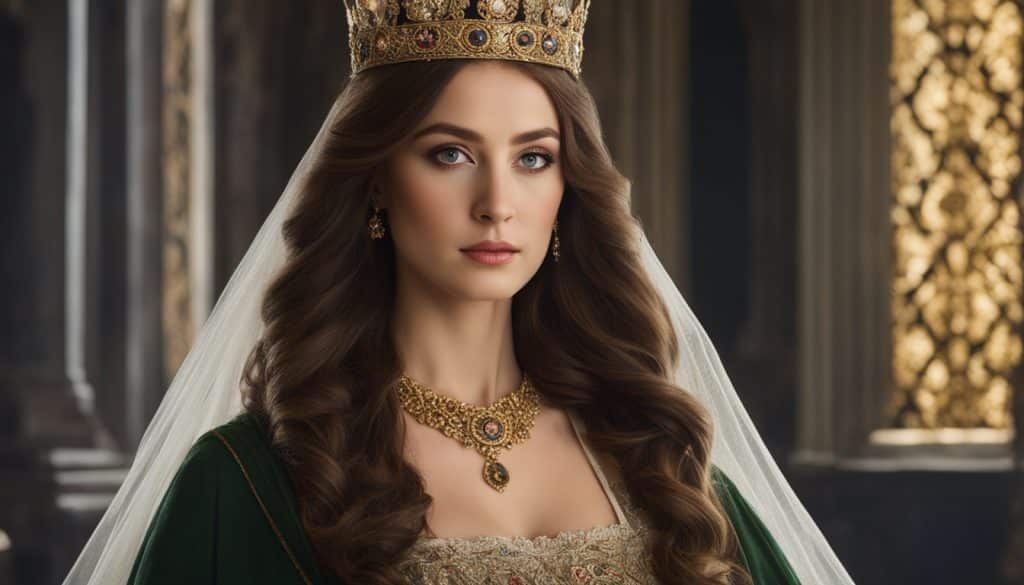Have you ever got totally absorbed in a biography? Felt a connection with someone from another era? Their stories of victory, loss, and daily life make them more than just names in our history books. They become real people who have left a mark on our world. From Cleopatra’s magnificent rule to Julius Caesar’s boundless ambition, their lives are truly inspiring.
Imagine the strength of Hatshepsut, an ancient Egyptian female pharaoh. She broke gender barriers to lead with elegance and power from c1473–1458 BC1. Consider the cultural bloom under Amenhotep III, signifying a time of wealth in the 18th dynasty1. And Alexander the Great’s massive empire, covering three continents and about 2 million square miles1, cannot be forgotten.
Their stories are not just old tales; they shape our modern world. Join us as we dive into the captivating lives, achievements, and enduring effects of these historic influencers. Whether you’re intrigued by Cleopatra’s intriguing alliances or admire King Alfred the Great’s reforms, these legendary figures touch something in all of us.
Key Takeaways
- The stories of notable figures often mirror our own challenges and victories.
- Hatshepsut’s time as pharaoh broke the period’s gender norms1.
- Amenhotep III’s reign was a high point of cultural and artistic success1.
- Alexander the Great’s vast empire shows his incredible reach1.
- These historic individuals still influence today’s culture and social structures.
The Legacy of Hatshepsut: Egypt’s Female Pharaoh
The story of Egypt‘s female pharaoh, Hatshepsut, is truly captivating and inspiring. She took the throne in 1479 BC, ruling Egypt as a strong monarch alongside Thutmose III2. Hatshepsut stands out because she redefined royal leadership and was the first to wear the pharaoh’s titles and clothes3.
Hatshepsut’s Royal Reign
In the long history of ancient Egypt, Hatshepsut was the third woman to become pharaoh. She was the first to hold full power2. Her rule from about 1473–1458 BCE brought peace and wealth. She chose trade over war, leading to prosperous trading missions to Punt. These brought back treasures like gold and incense3.
Her building projects are also famous. She built giant obelisks at Karnak and her burial place, the Temple of Deir el Bahri3. Indeed, Hatshepsut made a lasting impact on Egyptian architecture that we still remember today4.
Depictions of Power and Authority
Hatshepsut did something no woman had done before; she became a full-on pharaoh alongside Thutmose III2. In statues and pictures, she was shown with a man’s body, wearing the pharaoh’s clothes, to show she was boss3. She took all the pharaoh’s titles, highlighting her power in a male-dominated Egypt4.
But after she died in 1458 B.C., her stepson Thutmose III tried to make everyone forget her. He damaged her statues and took her name off buildings4. Yet, the discovery of hieroglyphics in 1822 uncovered her story, proving her one of Egypt’s greatest rulers.
The Golden Age of Amenhotep III
Amenhotep III was a powerful pharaoh of the 18th dynasty, ruling when ancient Egypt was most prosperous. From 1390 BC to 1353 BC, his era was marked by wealth and cultural achievements5. This time is often called Egypt’s golden age. Amenhotep III’s rule had a huge impact through his support of the arts and massive building works, leaving a lasting legacy.
Amenhotep III’s Influence on Egyptian Craftsmanship
Under Amenhotep III, Egyptian craftsmanship reached new heights of luxury. His era was known for stunning jewelry, detailed statues, and beautifully made pottery5. This period showed off Egypt’s wealth and its refined taste in art. Amenhotep himself was featured in many detailed statues. These works display the skill of artisans in working with various materials during this golden age.
Monumental Construction Projects
Amenhotep III’s major constructions show the magnificence and innovation of his time. One famous project was his mortuary temple in Thebes. It featured giant statues, like the Colossi of Memnon, at its entrance5. He also built a grand temple in Soleb, Nubia. This work further highlighted his architectural impact5.
Amenhotep III also used his building projects to strengthen political ties. The Amarna Letters show how he traded valuable items like gold and horses for building materials5. He made political marriages and sought alliances to gather resources for his ambitious buildings5. These efforts showcase the period’s architectural and political cleverness.
| Amenhotep III’s Contributions | Details |
|---|---|
| Reign | 1390 BC to 1353 BC5 |
| Major Construction Projects | Mortuary temple in Thebes, Temple at Soleb5 |
| Key Political Alliances | Marriages with Mitanni, Babylonian rulers; Proposed marriage with Hittite princess5 |
| Artistic Achievements | Intricate jewelry, statues, pottery |
| Diplomatic Exchanges | Gold, horses, copper, lapis lazuli via Amarna Letters5 |
Alexander the Great: Conqueror of the Persian Empire
Alexander the Great is remembered as a legendary conqueror. He was born in 356 BCE in Pella, Macedonia. By age 20, he became king, in 336 BCE67. His mission to grow the Macedonian empire is unforgettable, involving many epic battles.
Alexander’s Military Strategies
Alexander’s military mind was brilliant. His victory at the Granicus River in May/June 334 BCE showed his sharp strategies. Leading 30,000 foot soldiers and 5,000 cavalry, he crushed the Persian army67. His forces included 14,000 Macedonians and about 7,000 allies from the Greek League, crucial in defeating Persia6.
At the Battle of Issus in 333 BCE, Alexander scored a major win against King Darius III7. The Macedonian phalanx, with their long spears, was a fierce force in battle6.
- Battle of Thebes (335 BCE): Put down the Theban uprising7.
- Battle of Issus (333 BCE): Alexander’s first big victory against King Darius III7.
- Siege of Tyre (332 BCE): Built a causeway to storm the city, taking seven months7.
- Battle of Gaugamela (331 BCE): Defeated Darius III, securing control over Persia7.
The Empire That Spanned Continents
Under Alexander, the Macedonian empire spanned Europe, Asia, and Africa. He was seen as a hero in Egypt in 332 BCE6. His rule spread Greek culture, governance, and new ideas, making him a historic figure. Despite injuries, including a head wound and a lung pierced by an arrow, Alexander never gave up7. His last significant battle in 326 BCE at the Hydaspes showed his military brilliance and earned him a place in history7.
Jesus Christ: The Central Figure of Christianity
Jesus Christ was born around 6 B.C. in Bethlehem and is key in Christianity8. He started his work at 30 after John the Baptist baptized him in Galilee89.
Christianity, the biggest religion today, is built on Jesus’ teachings. Almost all scholars agree he really existed10. Matthew and Luke say he was born in Bethlehem but raised in Nazareth9. His ministry was short, ending with his death by Pontius Pilate9.
Jesus is known for his teachings and miracles, like turning water into wine8. The Gospels of Matthew, Mark, Luke, and John tell his story in detail10.
Tacitus, a Roman historian, also talks about Jesus, showing his wide impact9. Jesus’ followers’ belief in his resurrection helped spread Christianity9. Mary Magdalene played a big part in his story8.
Christian beliefs hold that Jesus was King David’s heir, meant to bring back Israel’s glory9. His betrayal by Judas for silver led to his arrest8.
Jesus is respected as a prophet in Islam, but not as the messiah in Judaism10. The Acts of the Apostles adds more to his story10.
Jesus Christ has a lasting impact. We celebrate his birth at Christmas and follow his lessons10. Learn more about his life here.
Cleopatra: The Last Pharaoh of Ancient Egypt
Cleopatra VII stands out as a legendary figure in history. She was Egypt’s last pharaoh and known for her wise tactics. Her leadership was defined by smart moves and key relationships.
Cleopatra’s Political Achievements
Born into the Ptolemaic dynasty in 69 B.C., Cleopatra faced a lot of challenges11. She was a smart planner, teaming up with powerful Romans. She first ruled with her brothers, then her son, Caesarion12.
Her deals extended Egypt’s reach to include Cyprus, Libya, and the Middle East11. Despite pressure, especially from Rome, she kept Egypt stable and strong.
Famous Relationships and Legacy
Cleopatra’s personal life influenced her rule. Her son with Julius Caesar made her stronger11. After Caesar’s death, she joined forces with Mark Antony. This bond brought them three children11. Antony’s marriage to Octavia caused more trouble, though.
Their union faced a big test at the Battle of Actium in 31 B.C1112.. They were defeated by Octavian, leading to Cleopatra’s tragic end at 3912.
Cleopatra’s story of her life and death remains powerful. She highlights the struggles and greatness of historical queens. Her story will always be remembered.
The Inspiring Rule of Ashoka the Great
Ashoka the Great was a key figure in ancient Indian history, leading the Mauryan Empire from 268 BCE to 232 BCE13. His rule brought major changes in politics and culture, particularly spreading Buddhism throughout Asia.
Spread of Buddhism Across Asia
Ashoka was first known for his harsh ways. But everything changed after the Kalinga War around 260 BCE, which took about 100,000 lives14. Shocked by the war’s horror, he turned to Buddhism. He swore off war, championing nonviolence and kindness instead14.
Ashoka helped Buddhism grow. He supported missions to places like Sri Lanka, spreading Buddha’s teachings. These efforts helped Buddhism reach far and wide in Asia, encouraging cultural connections13.
The Ashoka Chakra and Its Symbolism
The Ashoka Chakra on India’s flag shows Ashoka’s devotion to Buddhism. This 24-spoked wheel stands for the cycle of life and values like truth, faith, and fairness. It reminds us of Ashoka’s impact on Indian culture and his push for a just, moral society through Buddhism14.
“One must always strive to be truthful, compassionate, and just to foster a harmonious society.” – Ashoka the Great
Ashoka also worked on public welfare, building hospitals and planting trees along roads13. He set up wells and places for travelers to rest. These acts show his care for his people and his commitment to dharma.
Julius Caesar: Reformer and Dictator of Rome
Julius Caesar was a major figure in the Roman Republic’s history. He used his military skills to extend its territory and bring in new reforms. Born around July 12 or 13, 100 BCE, Caesar made a lasting impact on Roman society and its government15.
Caesar’s Military Conquests
Caesar’s battles led to the annexation of Gaul, which is now France, Belgium, and Switzerland, during the Gallic Wars16. In 55 BCE, his forces swiftly built a bridge over the Rhine River in 10 days. This move helped defeat German tribes that were a threat to Gaul16. Also, Caesar ventured across the English Channel into Britain twice in 55 BCE. These efforts laid the groundwork for Rome’s future dominance in Britain16. His leadership in battle greatly expanded Rome’s domain and strengthened its influence.
Reforms and the Julian Calendar
In 46 BCE, Caesar began his 10-year dictatorship of Rome, declaring himself “dictator for life” in 45 BCE. This decision was bold and eventually led to his killing on the Ides of March1617. He initiated reforms that were popular among the poor and middle classes. These included giving land to former soldiers and the poor16.
His introduction of the Julian calendar in 45 BCE marked a significant achievement. With help from the Greek mathematician Sosigenes, he created a calendar based on the solar year with a leap day every four years16. This new system replaced the old Roman lunar calendar17. Even though it was later adjusted by Pope Gregory XIII in 1582, Caesar’s calendar was an important step forward at that time.
Wu Zetian: The Only Female Emperor of China
Wu Zetian was born in AD 624 and became China’s only female emperor18. She started her rule in AD 690, leading the Wu Zhou dynasty until AD 70519. Her time as emperor was a big change from traditional roles in China20.
Under her leadership, China grew stronger and expanded19. Wu Zetian helped trade with the West and Eurasia, boosting the economy20. Her efforts made China a major world power19.
She changed the imperial exam system to allow more people a fair chance at government jobs18. This move made skill more important than family connections for civil service positions19.
Buddhism became more popular during her rule, with many monks and nuns throughout the empire20. Her era is celebrated in the Longmen Grottoes statuary and the “Wordless Stele”19.
Wu Zetian also used spies to keep her empire under control and well-informed19. This shows she was very strategic and knew how to manage her empire well.
Even though some people didn’t agree with her ways, Wu Zetian’s impact is still honored. Her story fascinates those who study China’s Tang dynasty and its history.
Boudica: The Warrior Queen of the Iceni Tribe
Boudica was a legendary queen of the Iceni Tribe, known for her fight against Roman Britain. Born around A.D. 30, she came from an elite family in what is now Colchester. She was married to Prasutagas, the Iceni king21. Together, they had two daughters and ruled their people, who were at peace with the Romans.
That peace broke down when Prasutagas died in A.D. 60. The Romans took their land, mistreating Boudica and her daughters. This led Boudica to lead a fierce rebellion21. Her uprising is a famous event in the story of ancient British warriors.
The Revolt Against Roman Britain
In A.D. 60, Boudica began her revolt, gathering an army of about 230,000 Britons22. Moved by injustice, her army destroyed cities like Camulodunum, Londinium, and Verulamium. This resulted in 70,000 to 80,000 Romans and their allies dying23. Her forces also defeated the Roman Ninth Legion, a major blow to Rome.
Boudica’s siege aimed to remove the Romans and regain Iceni independence. The Roman Governor Suetonius Paulinus fought her with a smaller force in a key battle believed to be at Watling Street21.
Destruction of Roman Strongholds
Boudica’s rebellion led to the destruction of key Roman sites. Londinium, an important Roman base, was completely destroyed by her forces22. The cities of Camulodunum and Verulamium also fell, causing panic among Romans and their supporters. These actions killed approximately 80,000 people, including soldiers and collaborators23.
However, the final battle did not go in Boudica’s favor. Despite her early victories, Governor Suetonius’s strategy and his disciplined soldiers defeated her. The end of Boudica is uncertain, with some saying she died from her wounds or by her own hand to avoid capture2321.
Boudica’s courage against Rome’s power remains inspiring. Her story shows the strong will of ancient British warriors. She symbolizes the eternal fight for freedom and justice. For detailed information on Boudica, click here23.
Matilda of England: The Forgotten Queen
Many people don’t know Matilda of England, but her story is fascinating. Called Empress Matilda, she was born on February 7, 1102. She was Henry I of England’s only surviving legitimate child2425. Her life was full of battles, showing the tough fight for the English throne amid civil war.
Struggle for the English Throne
Matilda married the Holy Roman Emperor, Henry V, when she was just eight. She became a widow in 1125 and went back to England25. Her father made sure the barons promised to see her as the next ruler25. But when Henry I died in 1135, her cousin Stephen took the throne instead, starting a war called The Anarchy26.
During this time, Matilda fought hard for her right to the throne. She even made a daring escape across a frozen Thames26.
Legacy of Her Son, Henry II
Empress Matilda didn’t become queen, but her son, Henry II, made a big impact. Thanks to her marriage to Geoffrey of Anjou, they had Henry II, who became king in 1154. This ended the civil war and began the Angevin Empire2426. Matilda’s strength and her vital role in England’s history are unforgettable.
Matilda’s life is a crucial piece of English history. It shows the powerful yet hidden roles of women. Empress Matilda, a forgotten queen, left a legacy that deeply affected England’s future.
William the Conqueror: Transforming Anglo-Saxon England
William the Conqueror was born in 1028 in Falaise, Duchy of Normandy27. He played a huge role in changing England’s history with his victory at the Battle of Hastings in 106628. This battle, which happened 950 years ago, is very important in English history28.
After becoming King of England on Christmas Day 1066, William started big changes27. He brought in the feudal system, which made a clear structure of lords and vassals. This helped Normans control England. The Domesday Book, made in 1086, is one of William’s most important achievements2728.
William’s rule also changed English architecture and language28. Before him, England had only a few castles. Under his rule, many castles and abbeys were built, changing the country’s look. Norman French became the main language of the upper class for 300 years, deeply influencing English culture28. William even introduced new foods like cider and rabbits to the British28.
William ended slavery in Anglo-Saxon England, where 15-20% of people were slaves28. His leadership changed the social and economic landscape. He introduced surnames, changing how people were named from the Anglo-Saxon way of using nicknames28.
- William the Conqueror changed England with the Norman conquest from 1066 to 108727.
- The Battle of Hastings’s 950th anniversary shows the big societal changes by the Normans28.
- The feudal system and the Domesday Book, made in 1086, were key in changing English society2728.
William died in 1087 during a campaign in northern France27. His death led to his lands being split between his sons, with Normandy going to Robert and England to William Rufus. William’s lasting mark was his ability to change Anglo-Saxon England with his military skills, strategic changes, and impacts on culture and buildings.
William the Conqueror’s rule highlights the Norman conquest’s importance2728. It shows how the Battle of Hastings and the feudal system reshaped England’s ruling class and buildings.
Henry II: First Plantagenet King of England
Henry II became the first Plantagenet king and made huge changes to English law. He was born in 1133 in Le Mans, Maine, and died in 1189 near Tours. His rule started in 1154 and lasted for 34 years2930. Henry ruled lands from Scotland to the Pyrenees, including places like Normandy and Aquitaine29. Even though he was king for over 30 years, he only spent 14 years in England. This was because he had a big empire and faced many conflicts29.
Feud with Thomas Becket
Henry II had a big fight with Thomas Becket. He thought by making Becket the Archbishop of Canterbury, he could control the Church. But Becket stayed loyal to the Church, setting off a long struggle. This fight ended with Becket’s murder in 1170, which worsened Henry’s reputation30.
Consolidation of Power
Despite the fight with Thomas Becket, Henry II grew his power. The Treaty of Wallingford in 1153 helped him become king after King Stephen30. He reformed the government and law, making them stronger30. Henry also improved conditions in Wales, Ireland, and Scotland30.
Henry II faced rebellion from his own family. His sons “Young Henry,” Richard, and Geoffrey turned against him with help from their mother, Eleanor of Aquitaine30. In the end, a fight led by Philip with Richard caused Henry to give up. He died in Chinon Castle, and Richard I took over30.
| Aspect | Details |
|---|---|
| Reign Start | 1154 |
| Reign End | 1189 |
| Legal Reforms | Significant, foundational for English Common Law |
| Major Conflict | Thomas Becket feud |
| Notable Territories | Normandy, Anjou, Aquitaine, Maine, Touraine |
| Children | Eight, including Richard I, Geoffrey |
Eleanor of Aquitaine: Queen of Two Nations
Eleanor of Aquitaine was a powerful figure in French and English royalty. She became the Duchess of Aquitaine in 1137 after her father died31. She then married Prince Louis, becoming Queen of France31.
Queen of France and England
Eleanor was queen consort of France and then England, guiding two great nations. As Louis VII’s queen, she had two daughters, Marie and Alice31. Their marriage ended in 1152. Shortly after, she married Henry II of England31.
Together, they welcomed eight children. Eleanor remained queen consort of England until 120432.
Eleanor took an active part in running the realm. She managed her lands and promoted culture, especially poetry, at the court of Poitiers32.
Trouble also found Eleanor. Henry II imprisoned her for nearly 16 years starting in 117331. Her son, Richard the Lion-Hearted, set her free when he became king in 118931. With Richard away on the Crusade, Eleanor ruled and prepared his coronation32.
Political Influence and Regency
After Henry II passed away in 1189, Eleanor’s political skills shone. She prepared for Richard’s coronation and led England in his absence32. She also secured French lands for her youngest son, John, after Richard died in 119932.
Eleanor was a savvy political strategist even into old age. She arranged marriages for her granddaughter at the age of 80 to strengthen family power33. She also built hospitals, improved roads, and standardized measurements, significantly impacting society33. Eleanor retired to Fontevrault Monastery, where she died in 120432.
| Role | Actions | Impact |
|---|---|---|
| Duchess of Aquitaine | Inherited and managed vast domains | Increased territorial power |
| Queen of France | Married Louis VII and bore two daughters | Strengthened Franco-Aquitaine relations |
| Queen of England | Married Henry II and bore eight children | Extended influence over England and France |
| Regent Queen | Governed in Richard I’s absence; managed realm | Ensured stability and continuity of rulership |
| Political Strategist | Arranged marriage alliances; managed territories | Secured dynastic power |
Famous: Notable figures’ stories
They range from powerful women to great monarchs. Their stories give us a peek into their worlds and how they made a difference. Their importance comes from both what they did and how they are remembered.
Influential Women in History
Queen Elizabeth I of England was a powerful woman in the 16th century, ranked 13th in history34. Her smart politics and diplomacy highlight her time as queen35. Hatshepsut, an Egyptian Pharaoh, broke gender rules and brought her country wealth and beautiful buildings35. These women’s stories show how they shaped history.
Legendary Kings and Queens
Alexander the Great was known for his battle skills and huge empire, reaching from Greece to India35. Julius Caesar changed Rome and started the Julian calendar, affecting governance and society35. Cleopatra VII of Egypt kept her throne through smart alliances during Roman threats34. Their tales mix ambition, strength, and solid leadership.
| Rank | Figure | Significance |
|---|---|---|
| 13 | Queen Elizabeth I | Highest-ranked woman in history |
| 19 | Albert Einstein | Most significant modern individual not selected as TIME’s Person of the Year |
| 7 | Adolf Hitler | One of the top 10 most significant figures in history |
An analysis of over 800,000 Wikipedia pages tried to rank historical figures by importance35. Despite criticism about using Wikipedia, this study gives a unique look at impactful individuals35. It shows the roles both men and women played in our past.
The Revolutionary Leadership of King Alfred the Great
King Alfred the Great was born in Wantage, Berkshire in 849. He became key in fighting off Viking invasions that had been a problem for Anglo-Saxon England for about 60 years3637. As the fifth son of King Aethelwulf of Wessex, Alfred had to deal with big challenges. This included threats from the Great Army of Northmen that arrived in East Anglia in 8653637.
From 871 to 899, Alfred ruled and made many changes that still affect England today. His win at the Battle of Edington in 879 was a key moment, dividing England between the Anglo-Saxons and Vikings38. Alfred didn’t just grow his kingdom. He also focused on education, setting up schools for smart priests and officials38.
Alfred’s legacy is big during the Viking Age. His tactics and the building of fortified towns (burhs) were crucial in protecting Wessex37. He was also ahead of his time in naval battles. In 851, Alfred beat the Danes in a big sea fight, the first of its kind in English history37.
King Alfred stood out for his focus on the English language and schooling. He was known for turning Latin texts into English, uniting Anglo-Saxon culture37. His love for learning was clear early on, like when he went to Rome and Pope Leo IV confirmed him in 85336.
Alfred’s impact outlived him, with his kids, including Edward the Elder and Æthelflæd, Lady of the Mercians, carrying on his work37. They played a big part in eventually bringing England together under his descendants38.
King Alfred’s mark is seen in history and literature. People like Archbishop Matthew Parker and John Foxe made sure his story was well known38. Indeed, Alfred’s leading style, clever strategy, and push for culture make his time as king stand out in Anglo-Saxon history.
| Key Event | Year | Significance |
|---|---|---|
| Birth of Alfred | 849 | The future king is born into a period of Viking invasions36 |
| Battle of Edington | 878 | Alfred defeats the Vikings, leading to the creation of Danelaw37 |
| Foundation of Alfred’s Schools | Mid-890s | Establishes educational reforms for better governance38 |
| Death of Alfred | 899 | Marks the end of a groundbreaking and transformative reign38 |
Conclusion
Throughout history, we meet people who have changed the world. Susan B. Anthony fought tirelessly for women’s rights. Leaders like Julius Caesar and Alexander the Great achieved great things. Each one left a lasting impact on our world.
Their leadership teaches us valuable lessons. They showed resilience, strategic thinking, and dedication. Susan B. Anthony’s story, for instance, shows how persistence can create big changes. Learn more about her journey here39.
Historians have different views on these figures. Some, like Hegel and Kierkegaard, highlight the role of “world-historical figures” in progress. Others, like Herbert Spencer and Karl Popper, question this view. They focus on society’s role and question the idea of inevitability in history39.
In the end, the stories of these iconic people inspire us. Their vision and determination show us the power of leadership. Let their lives motivate you as you find your own way.







